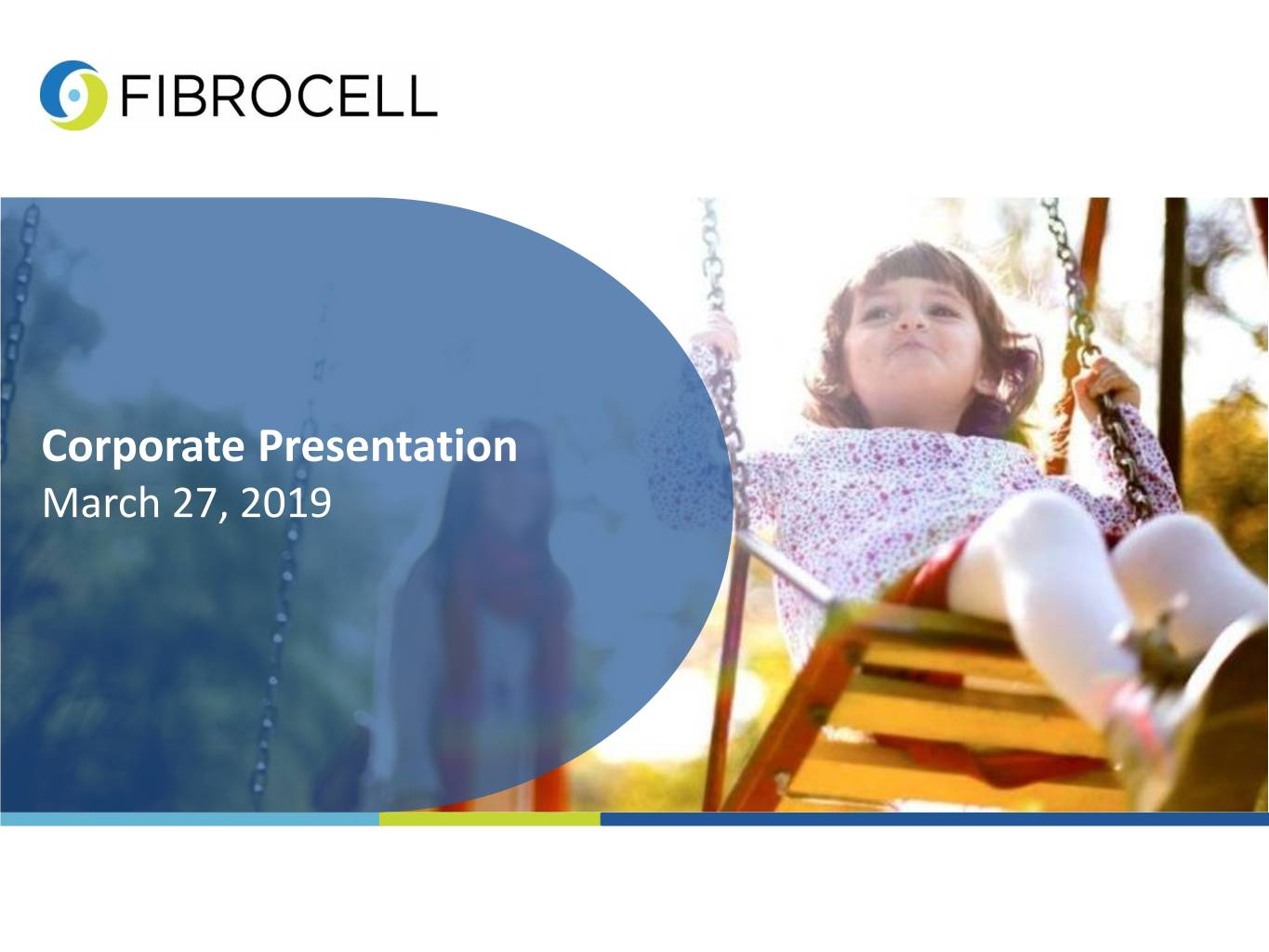
Corporate Presentation March 27, 2019

Forward-Looking Statements This presentation and our accompanying remarks contain “forward-looking statements” within the meaning of the U.S. Private Securities Litigation Reform Act of 1995. All statements that are not historical facts are hereby identified as forward-looking statements for this purpose and include, among others, statements relating to: our expectations regarding the timing and clinical development of FCX-007, including our plans to initiate a Phase 3 clinical trial for FCX-007 in the second quarter of 2019, the Phase 3 trial design and our expectation to enroll 15-20 patients; the timing of our Phase 1/2 clinical trial of FCX-013, including our expectation to complete enrollment of Phase 1 adult patients in the third quarter of 2019; the potential advantages of our product candidates; the sufficiency of our cash and cash equivalents to fund operations in the fourth quarter of 2019; and all other statements relating to our future operations, future financial performance, future financial condition, prospects or other future events. Forward-looking statements are based upon our current expectations and assumptions and are subject to a number of known and unknown risks, uncertainties and other factors that could cause actual results to differ materially and adversely from those expressed or implied by such statements. Factors that could cause or contribute to such differences include, among others: uncertainties and delays relating to the initiation, enrollment and completion of clinical trials; whether clinical trial results will validate and support the safety and efficacy of our product candidates; unanticipated or excess costs relating to the development of our gene therapy product candidates; our ability to obtain additional capital to continue to fund operations; uncertainties associated with being able to identify, evaluate and complete any strategic transaction or alternative; the impact of the announcement of any strategic transaction or alternative that may be pursued, on our business, including our financial and operating results and our employees; our ability to maintain our collaboration with Intrexon; and the other factors discussed under the caption “Item 1A. Risk Factors” in our most recent Form 10-K and Form 10-Qs which are available through the “Investors—SEC Filings” page of our website at www.fibrocell.com. As a result, you should not place undue reliance on forward-looking statements. The forward-looking statements made in connection with this presentation represent our views only as of the date of this presentation (or any earlier date indicated in such statement). While we may update certain forward-looking statements from time to time, we specifically disclaim any obligation to do so, even if new information becomes available in the future. 2
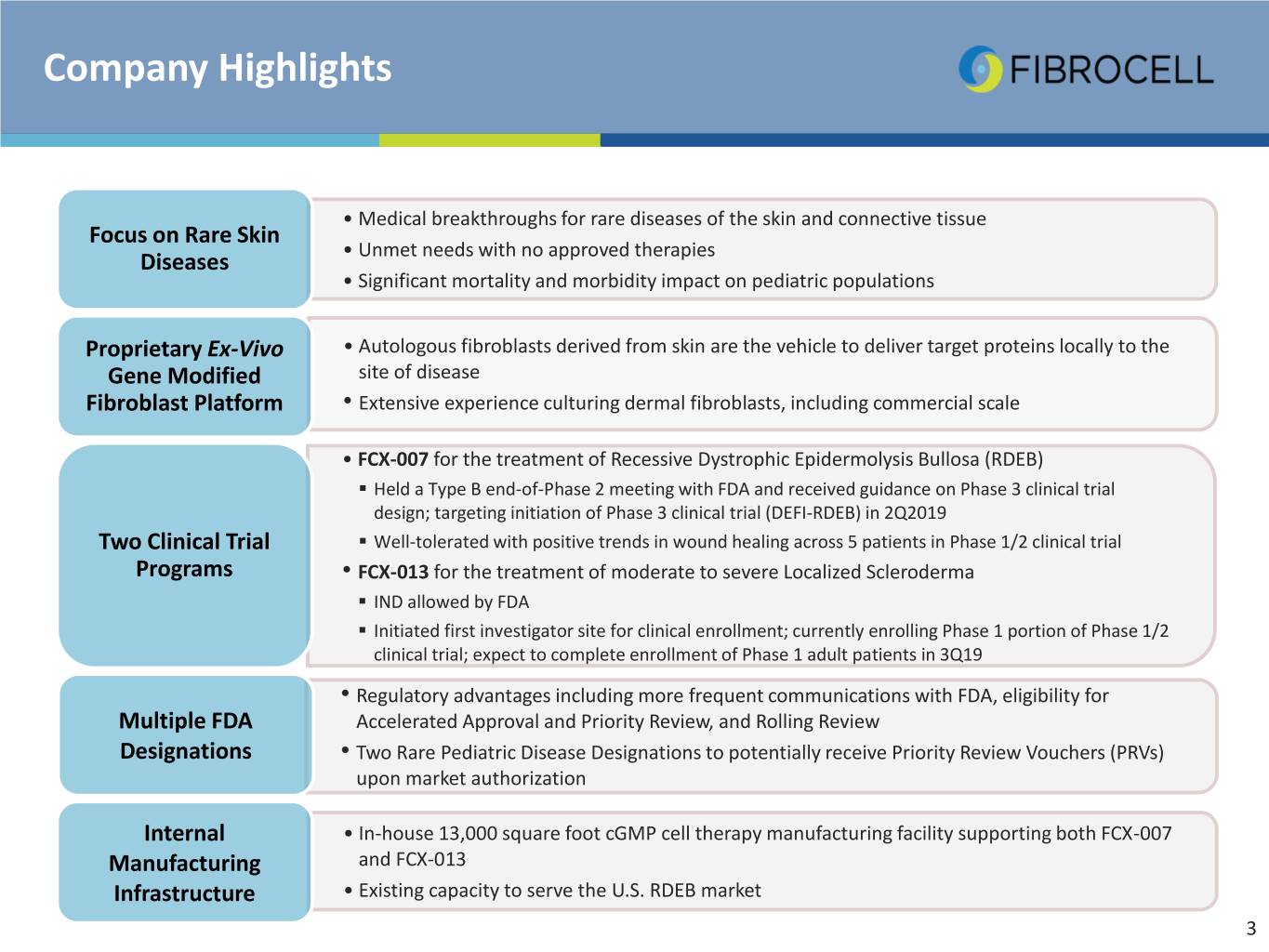
Company Highlights • Medical breakthroughs for rare diseases of the skin and connective tissue Focus on Rare Skin • Unmet needs with no approved therapies Diseases • Significant mortality and morbidity impact on pediatric populations Proprietary Ex-Vivo • Autologous fibroblasts derived from skin are the vehicle to deliver target proteins locally to the Gene Modified site of disease Fibroblast Platform • Extensive experience culturing dermal fibroblasts, including commercial scale • FCX-007 for the treatment of Recessive Dystrophic Epidermolysis Bullosa (RDEB) . Held a Type B end-of-Phase 2 meeting with FDA and received guidance on Phase 3 clinical trial design; targeting initiation of Phase 3 clinical trial (DEFI-RDEB) in 2Q2019 Two Clinical Trial . Well-tolerated with positive trends in wound healing across 5 patients in Phase 1/2 clinical trial Programs • FCX-013 for the treatment of moderate to severe Localized Scleroderma . IND allowed by FDA . Initiated first investigator site for clinical enrollment; currently enrolling Phase 1 portion of Phase 1/2 clinical trial; expect to complete enrollment of Phase 1 adult patients in 3Q19 • Regulatory advantages including more frequent communications with FDA, eligibility for Multiple FDA Accelerated Approval and Priority Review, and Rolling Review Designations • Two Rare Pediatric Disease Designations to potentially receive Priority Review Vouchers (PRVs) upon market authorization Internal • In-house 13,000 square foot cGMP cell therapy manufacturing facility supporting both FCX-007 Manufacturing and FCX-013 Infrastructure • Existing capacity to serve the U.S. RDEB market 3
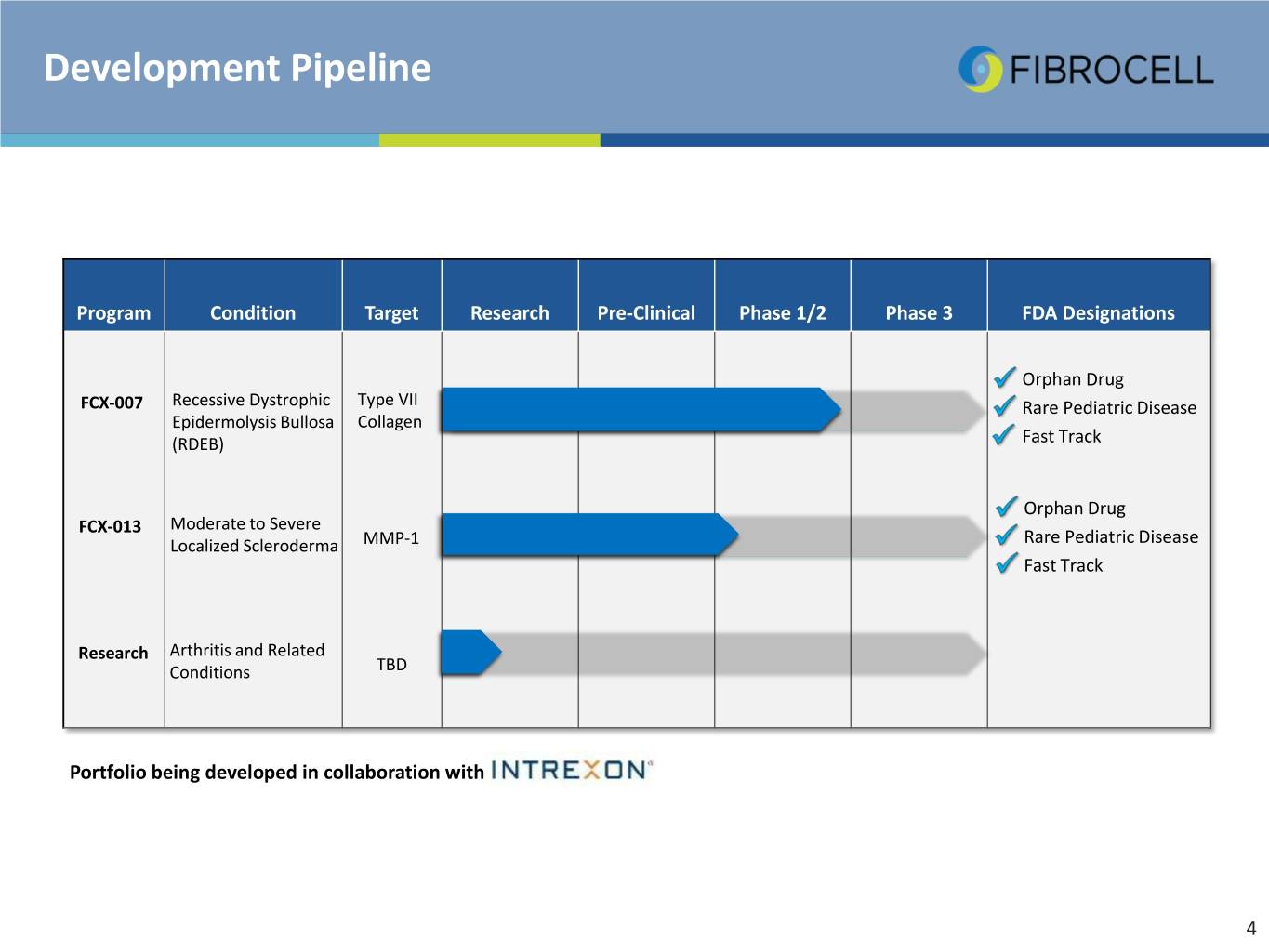
Development Pipeline Program Condition Target Research Pre-Clinical Phase 1/2 Phase 3 FDA Designations Orphan Drug FCX-007 Recessive Dystrophic Type VII Rare Pediatric Disease Epidermolysis Bullosa Collagen (RDEB) Fast Track Orphan Drug FCX-013 Moderate to Severe Localized Scleroderma MMP-1 Rare Pediatric Disease Fast Track Research Arthritis and Related Conditions TBD Portfolio being developed in collaboration with 4
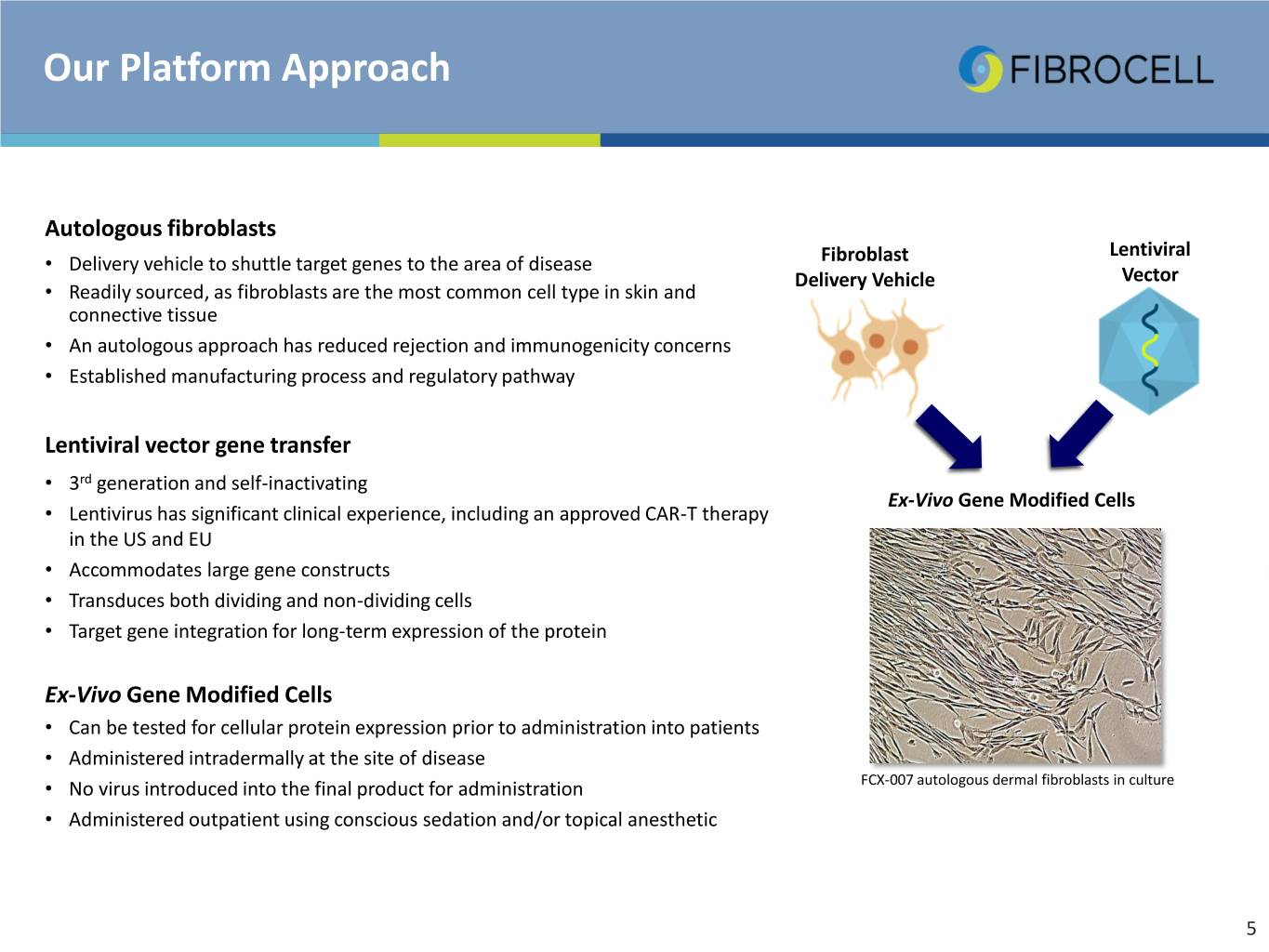
Our Platform Approach Autologous fibroblasts Lentiviral • Delivery vehicle to shuttle target genes to the area of disease Fibroblast Delivery Vehicle Vector • Readily sourced, as fibroblasts are the most common cell type in skin and Vector connective tissue • An autologous approach has reduced rejection and immunogenicity concerns • Established manufacturing process and regulatory pathway Lentiviral vector gene transfer • 3rd generation and self-inactivating Ex-Vivo Gene Modified Cells • Lentivirus has significant clinical experience, including an approved CAR-T therapy in the US and EU • Accommodates large gene constructs • Transduces both dividing and non-dividing cells • Target gene integration for long-term expression of the protein Ex-Vivo Gene Modified Cells • Can be tested for cellular protein expression prior to administration into patients • Administered intradermally at the site of disease • No virus introduced into the final product for administration FCX-007 autologous dermal fibroblasts in culture • Administered outpatient using conscious sedation and/or topical anesthetic 5
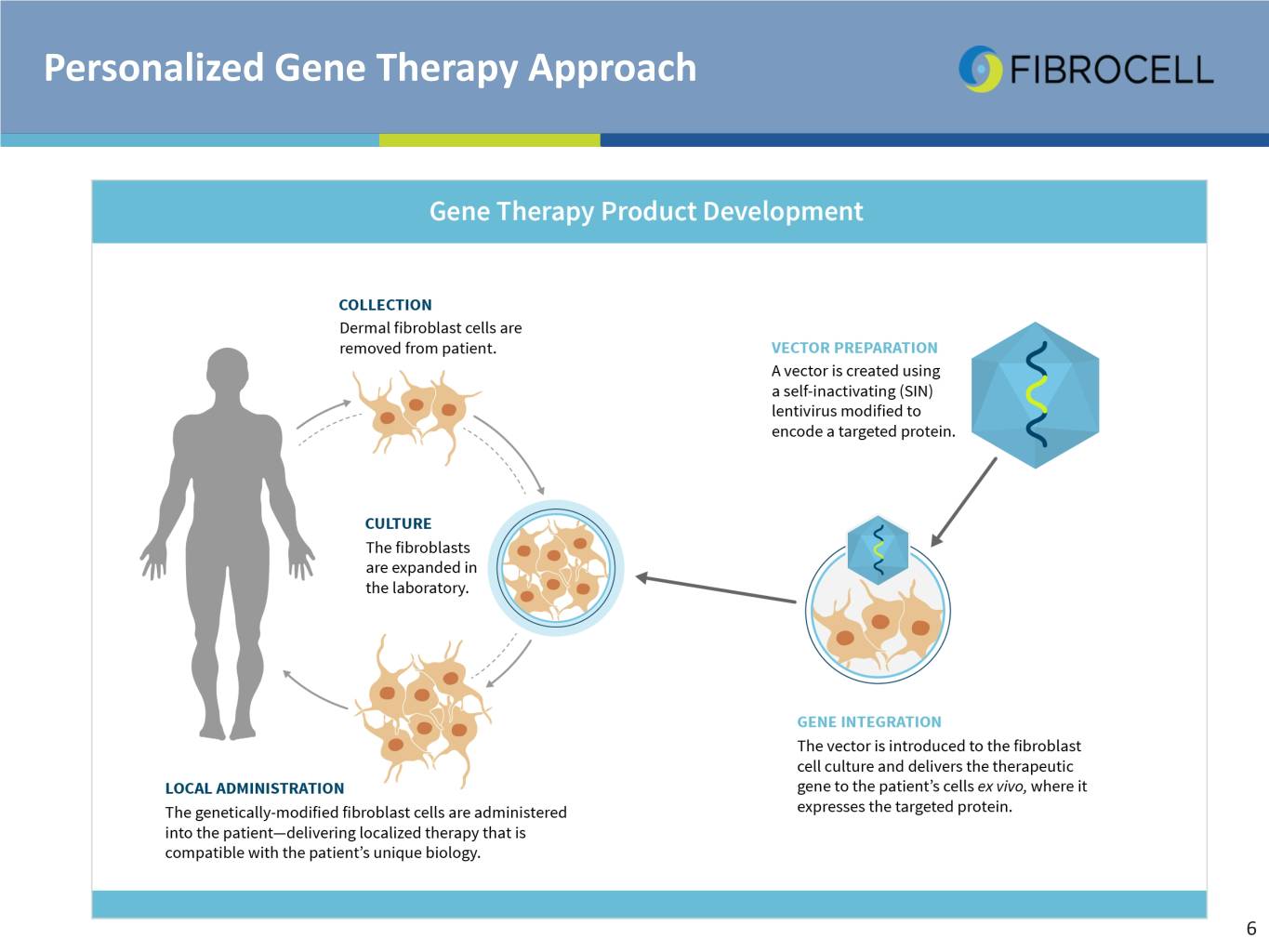
Personalized Gene Therapy Approach 6
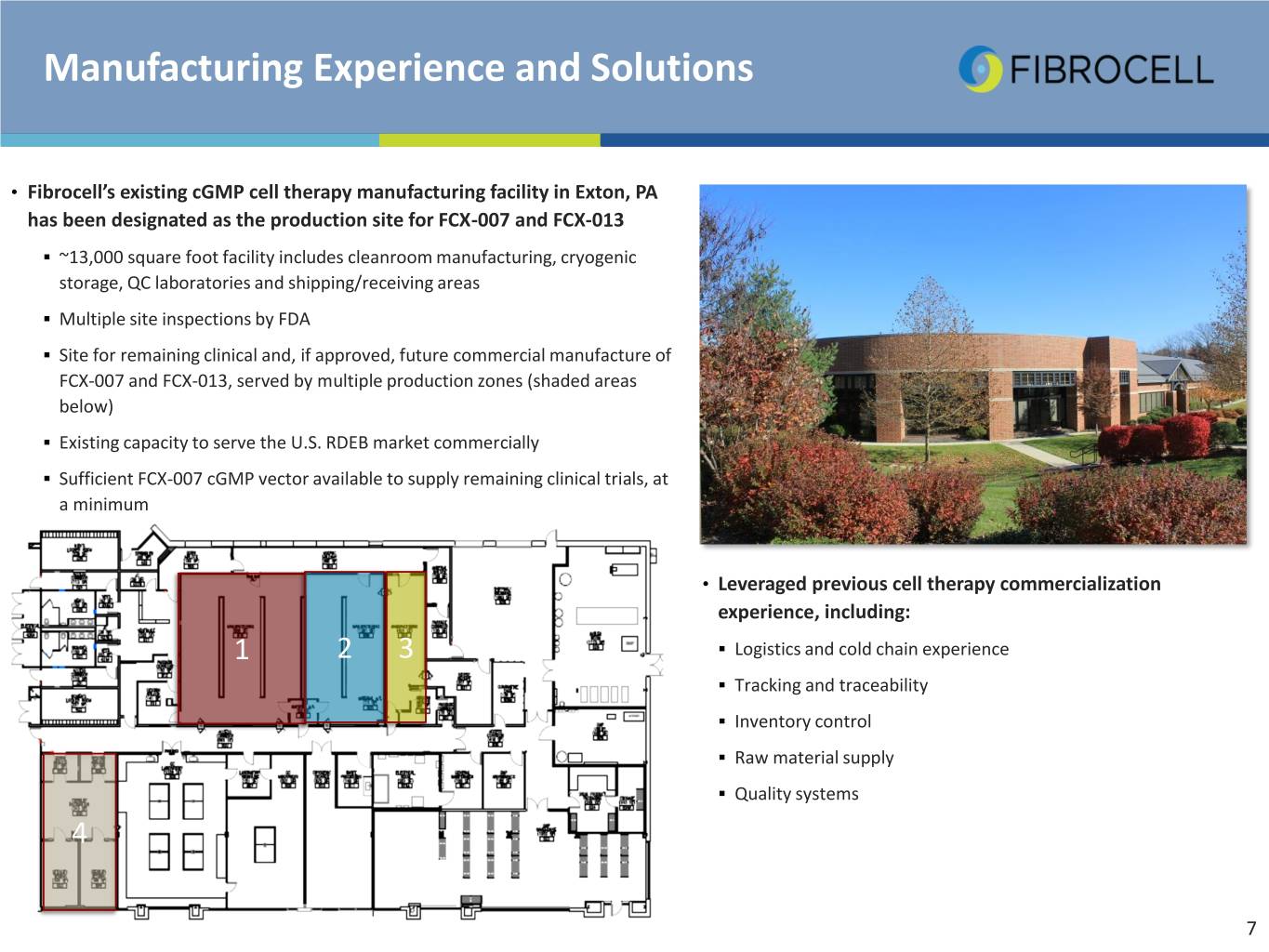
Manufacturing Experience and Solutions • Fibrocell’s existing cGMP cell therapy manufacturing facility in Exton, PA has been designated as the production site for FCX-007 and FCX-013 . ~13,000 square foot facility includes cleanroom manufacturing, cryogenic storage, QC laboratories and shipping/receiving areas . Multiple site inspections by FDA . Site for remaining clinical and, if approved, future commercial manufacture of FCX-007 and FCX-013, served by multiple production zones (shaded areas below) . Existing capacity to serve the U.S. RDEB market commercially . Sufficient FCX-007 cGMP vector available to supply remaining clinical trials, at a minimum • Leveraged previous cell therapy commercialization experience, including: 1 2 3 . Logistics and cold chain experience . Tracking and traceability . Inventory control . Raw material supply . Quality systems 4 7
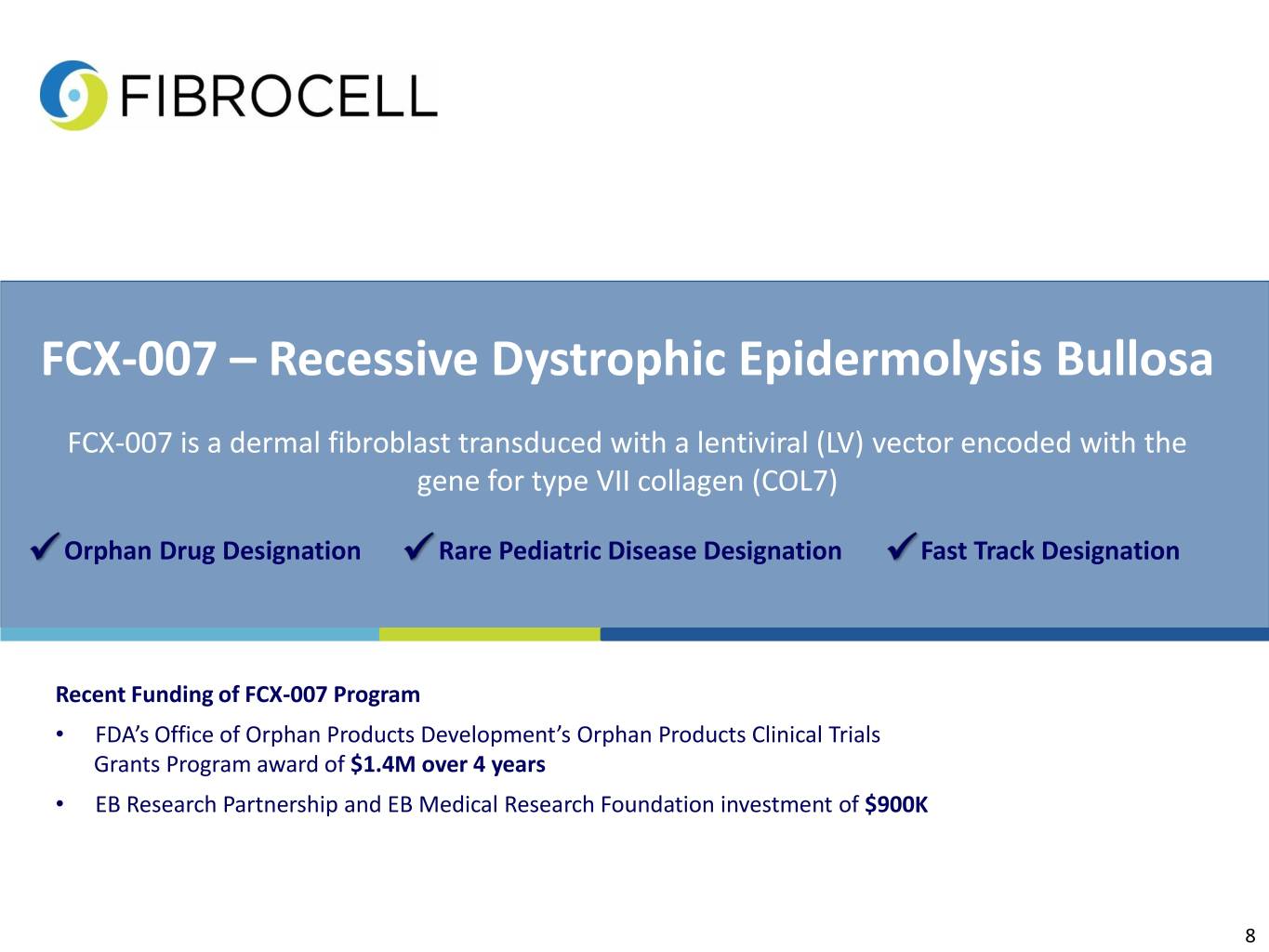
FCX-007 – Recessive Dystrophic Epidermolysis Bullosa FCX-007 is a dermal fibroblast transduced with a lentiviral (LV) vector encoded with the gene for type VII collagen (COL7) Orphan Drug Designation Rare Pediatric Disease Designation Fast Track Designation Recent Funding of FCX-007 Program • FDA’s Office of Orphan Products Development’s Orphan Products Clinical Trials Grants Program award of $1.4M over 4 years • EB Research Partnership and EB Medical Research Foundation investment of $900K 8
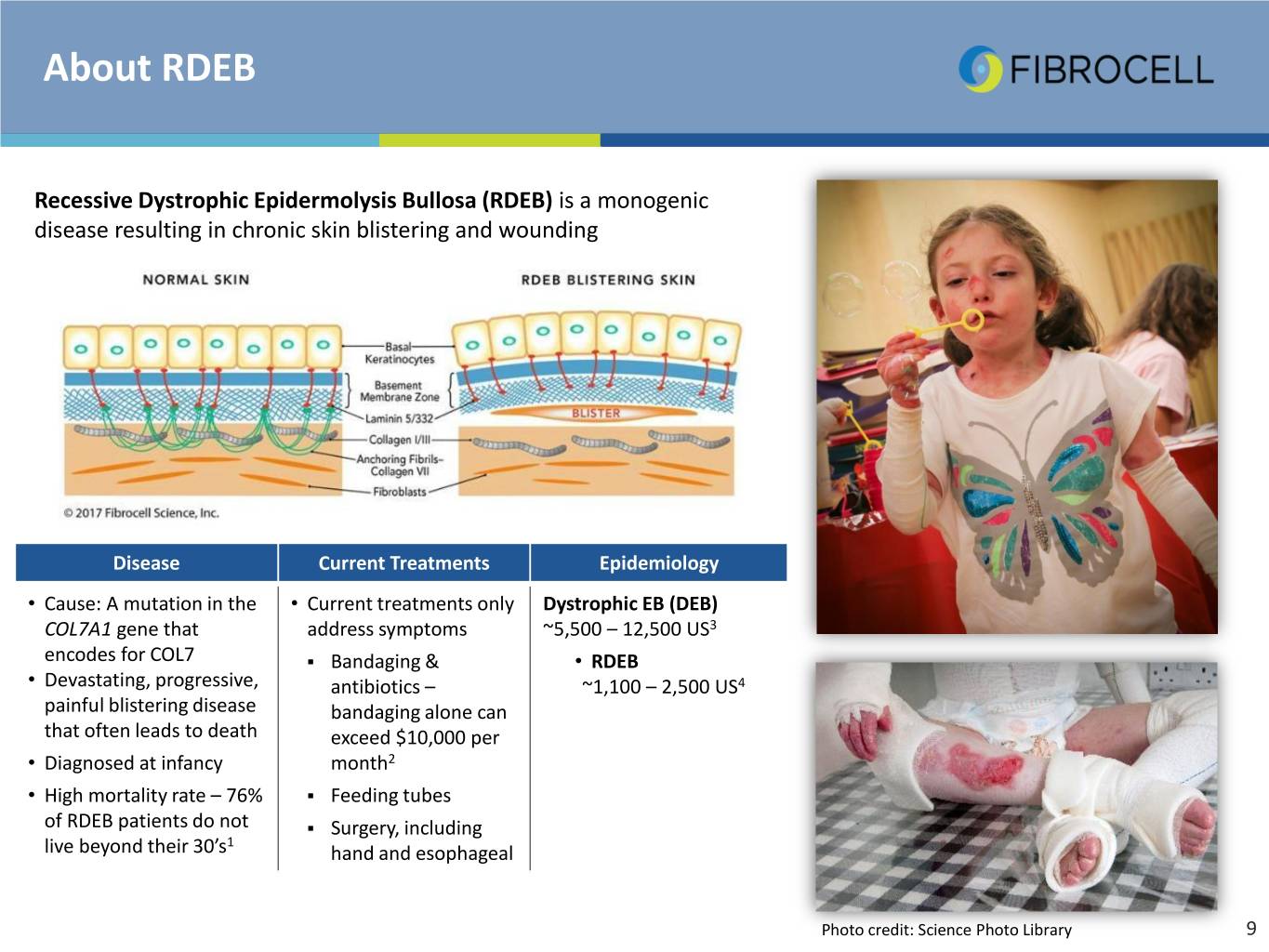
About RDEB Recessive Dystrophic Epidermolysis Bullosa (RDEB) is a monogenic disease resulting in chronic skin blistering and wounding Disease Current Treatments Epidemiology • Cause: A mutation in the • Current treatments only Dystrophic EB (DEB) COL7A1 gene that address symptoms ~5,500 – 12,500 US3 encodes for COL7 . Bandaging & • RDEB • Devastating, progressive, antibiotics – ~1,100 – 2,500 US4 painful blistering disease bandaging alone can that often leads to death exceed $10,000 per • Diagnosed at infancy month2 • High mortality rate – 76% . Feeding tubes of RDEB patients do not . Surgery, including 1 live beyond their 30’s hand and esophageal Photo credit: Science Photo Library 9
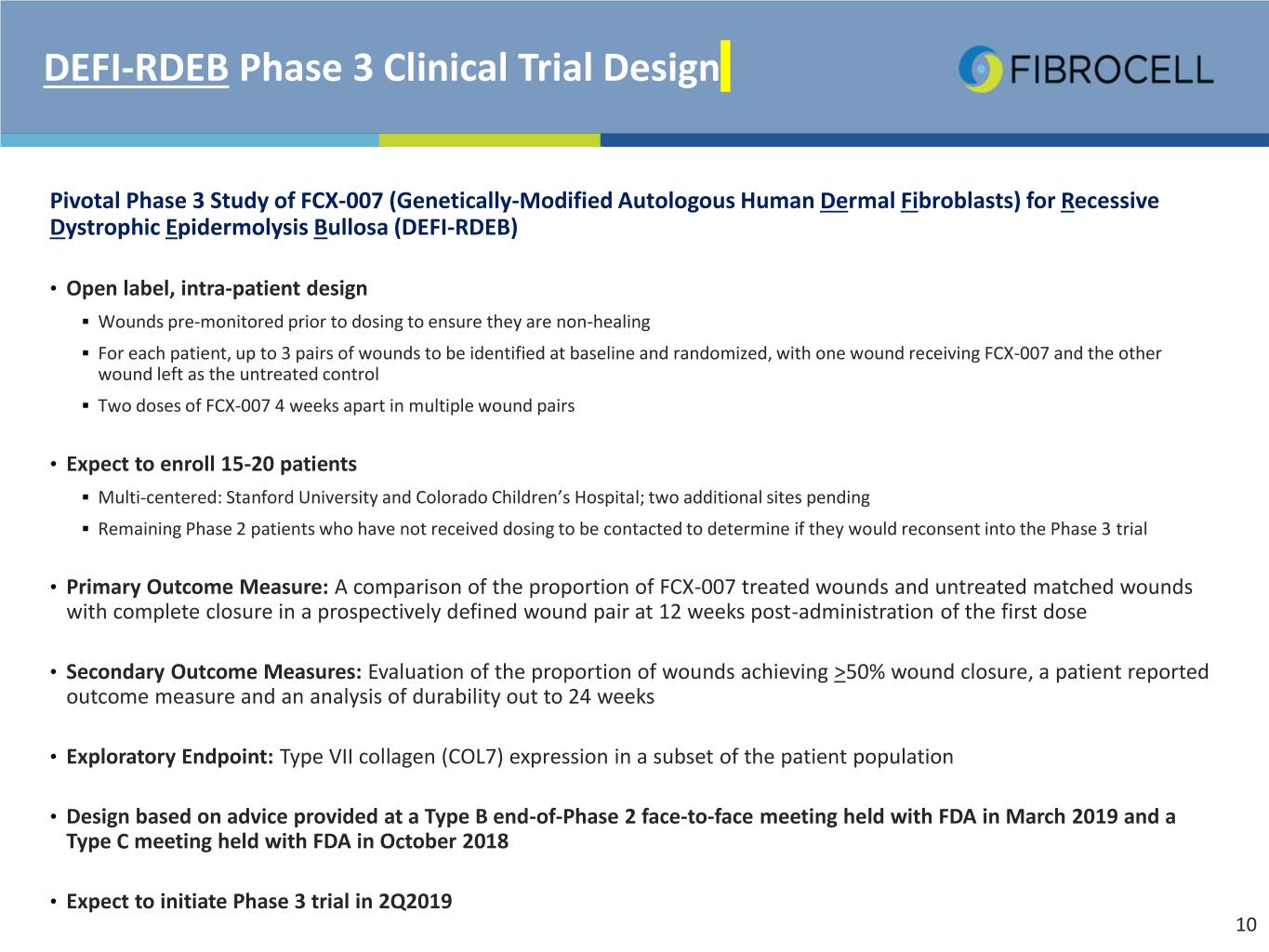
DEFI-RDEB Phase 3 Clinical Trial Design Pivotal Phase 3 Study of FCX-007 (Genetically-Modified Autologous Human Dermal Fibroblasts) for Recessive Dystrophic Epidermolysis Bullosa (DEFI-RDEB) • Open label, intra-patient design . Wounds pre-monitored prior to dosing to ensure they are non-healing . For each patient, up to 3 pairs of wounds to be identified at baseline and randomized, with one wound receiving FCX-007 and the other wound left as the untreated control . Two doses of FCX-007 4 weeks apart in multiple wound pairs • Expect to enroll 15-20 patients . Multi-centered: Stanford University and Colorado Children’s Hospital; two additional sites pending . Remaining Phase 2 patients who have not received dosing to be contacted to determine if they would reconsent into the Phase 3 trial • Primary Outcome Measure: A comparison of the proportion of FCX-007 treated wounds and untreated matched wounds with complete closure in a prospectively defined wound pair at 12 weeks post-administration of the first dose • Secondary Outcome Measures: Evaluation of the proportion of wounds achieving >50% wound closure, a patient reported outcome measure and an analysis of durability out to 24 weeks • Exploratory Endpoint: Type VII collagen (COL7) expression in a subset of the patient population • Design based on advice provided at a Type B end-of-Phase 2 face-to-face meeting held with FDA in March 2019 and a Type C meeting held with FDA in October 2018 • Expect to initiate Phase 3 trial in 2Q2019 10
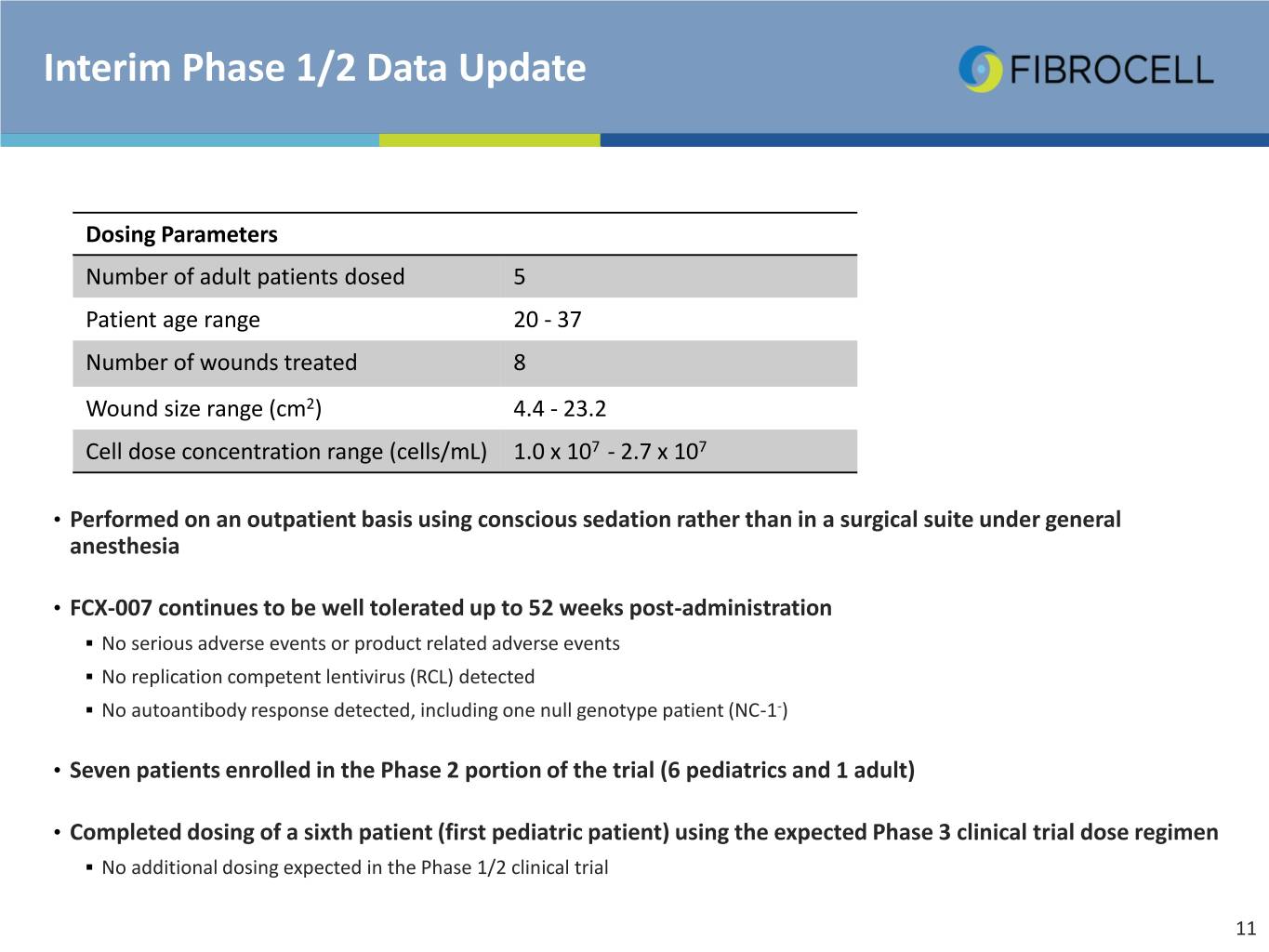
Interim Phase 1/2 Data Update Dosing Parameters Number of adult patients dosed 5 Patient age range 20 - 37 Number of wounds treated 8 Wound size range (cm2) 4.4 - 23.2 Cell dose concentration range (cells/mL) 1.0 x 107 - 2.7 x 107 • Performed on an outpatient basis using conscious sedation rather than in a surgical suite under general anesthesia • FCX-007 continues to be well tolerated up to 52 weeks post-administration . No serious adverse events or product related adverse events . No replication competent lentivirus (RCL) detected . No autoantibody response detected, including one null genotype patient (NC-1-) • Seven patients enrolled in the Phase 2 portion of the trial (6 pediatrics and 1 adult) • Completed dosing of a sixth patient (first pediatric patient) using the expected Phase 3 clinical trial dose regimen . No additional dosing expected in the Phase 1/2 clinical trial 11
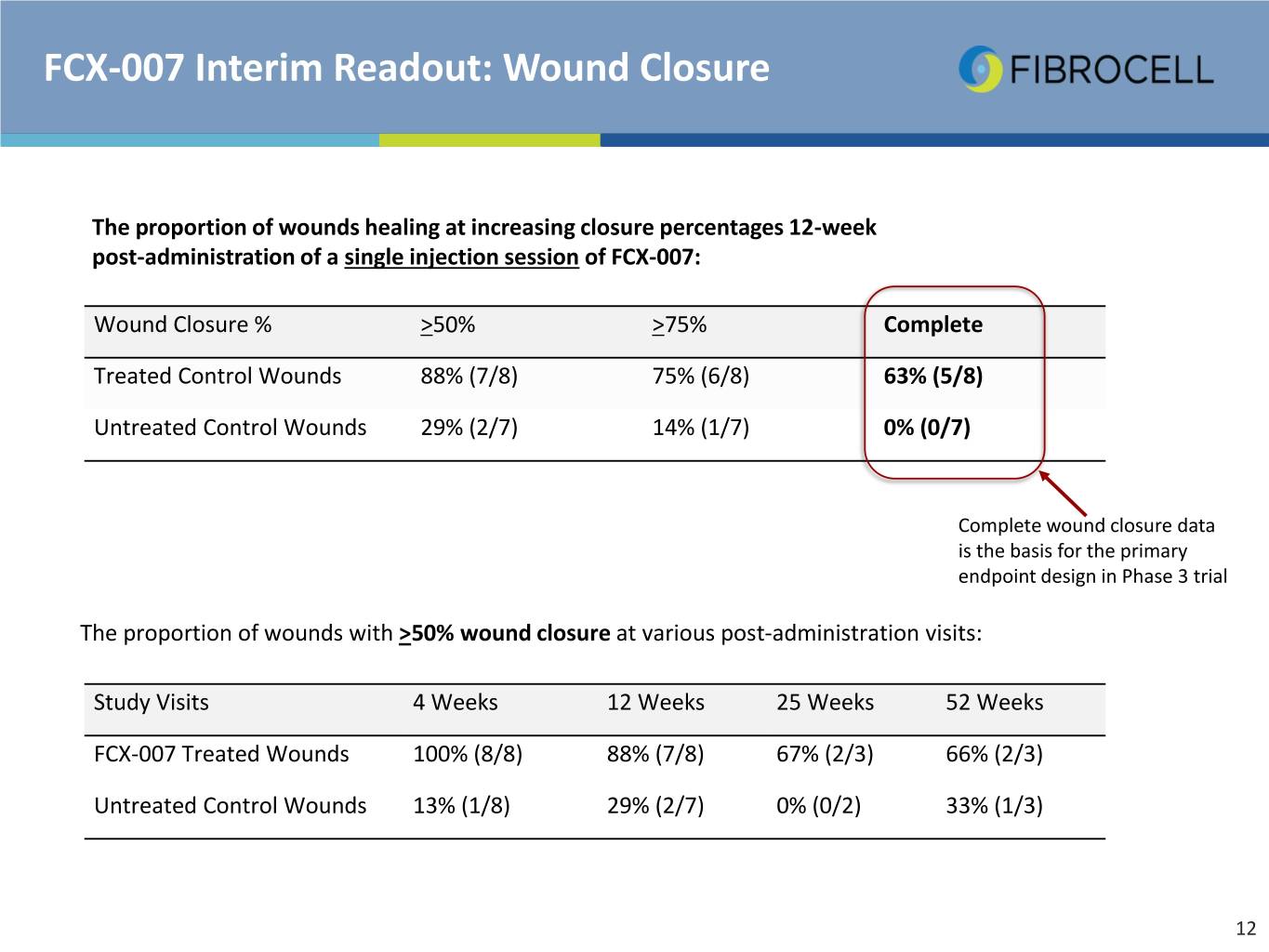
FCX-007 Interim Readout: Wound Closure The proportion of wounds healing at increasing closure percentages 12-week post-administration of a single injection session of FCX-007: Wound Closure % >50% >75% Complete Treated Control Wounds 88% (7/8) 75% (6/8) 63% (5/8) Untreated Control Wounds 29% (2/7) 14% (1/7) 0% (0/7) Complete wound closure data is the basis for the primary endpoint design in Phase 3 trial The proportion of wounds with >50% wound closure at various post-administration visits: Study Visits 4 Weeks 12 Weeks 25 Weeks 52 Weeks FCX-007 Treated Wounds 100% (8/8) 88% (7/8) 67% (2/3) 66% (2/3) Untreated Control Wounds 13% (1/8) 29% (2/7) 0% (0/2) 33% (1/3) 12
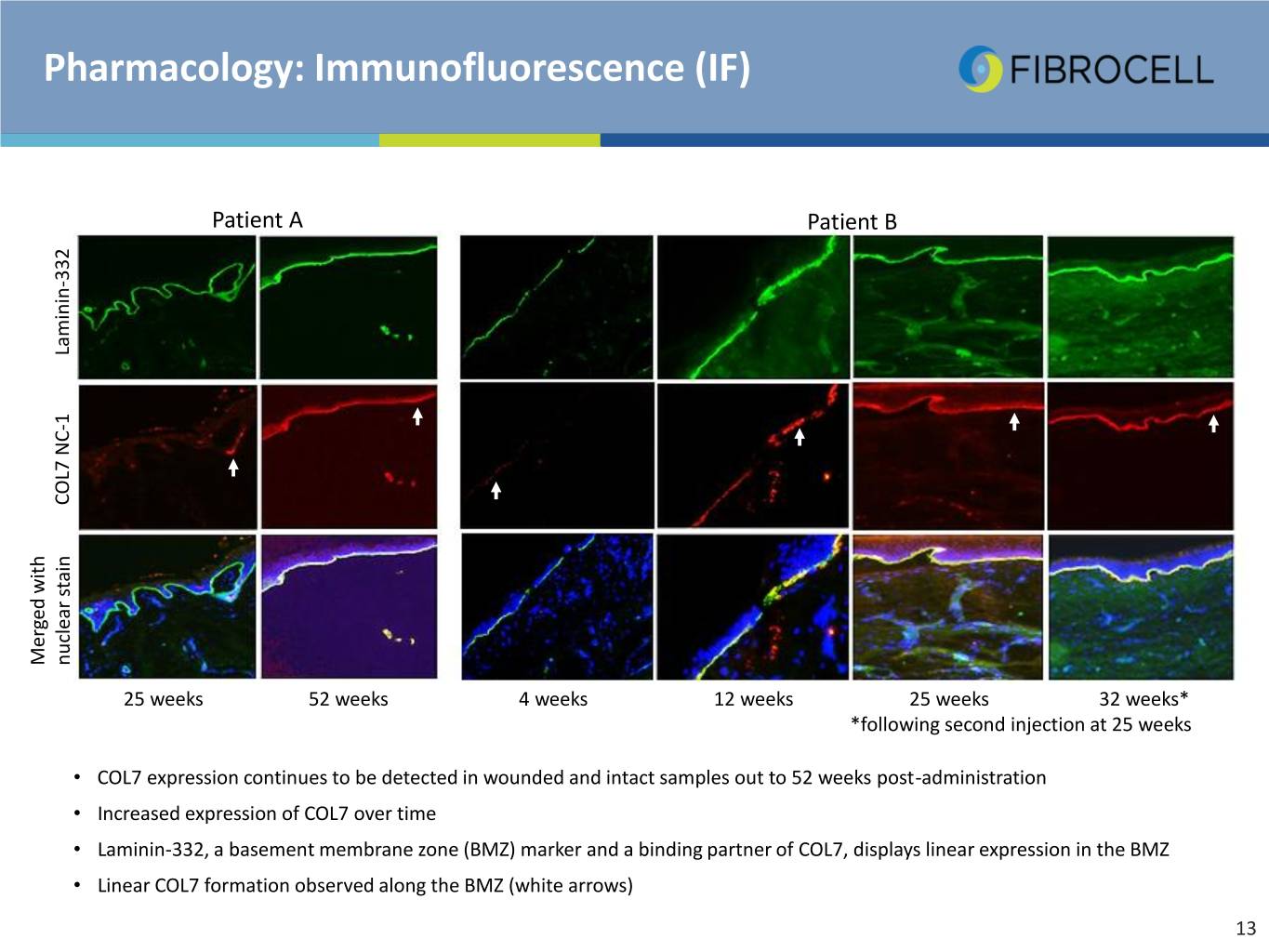
Pharmacology: Immunofluorescence (IF) Patient A Patient B 332 - 1 1 Laminin - COL7 NC COL7 Merged with Merged stain nuclear 25 weeks 52 weeks 4 weeks 12 weeks 25 weeks 32 weeks* *following second injection at 25 weeks • COL7 expression continues to be detected in wounded and intact samples out to 52 weeks post-administration • Increased expression of COL7 over time • Laminin-332, a basement membrane zone (BMZ) marker and a binding partner of COL7, displays linear expression in the BMZ • Linear COL7 formation observed along the BMZ (white arrows) 13
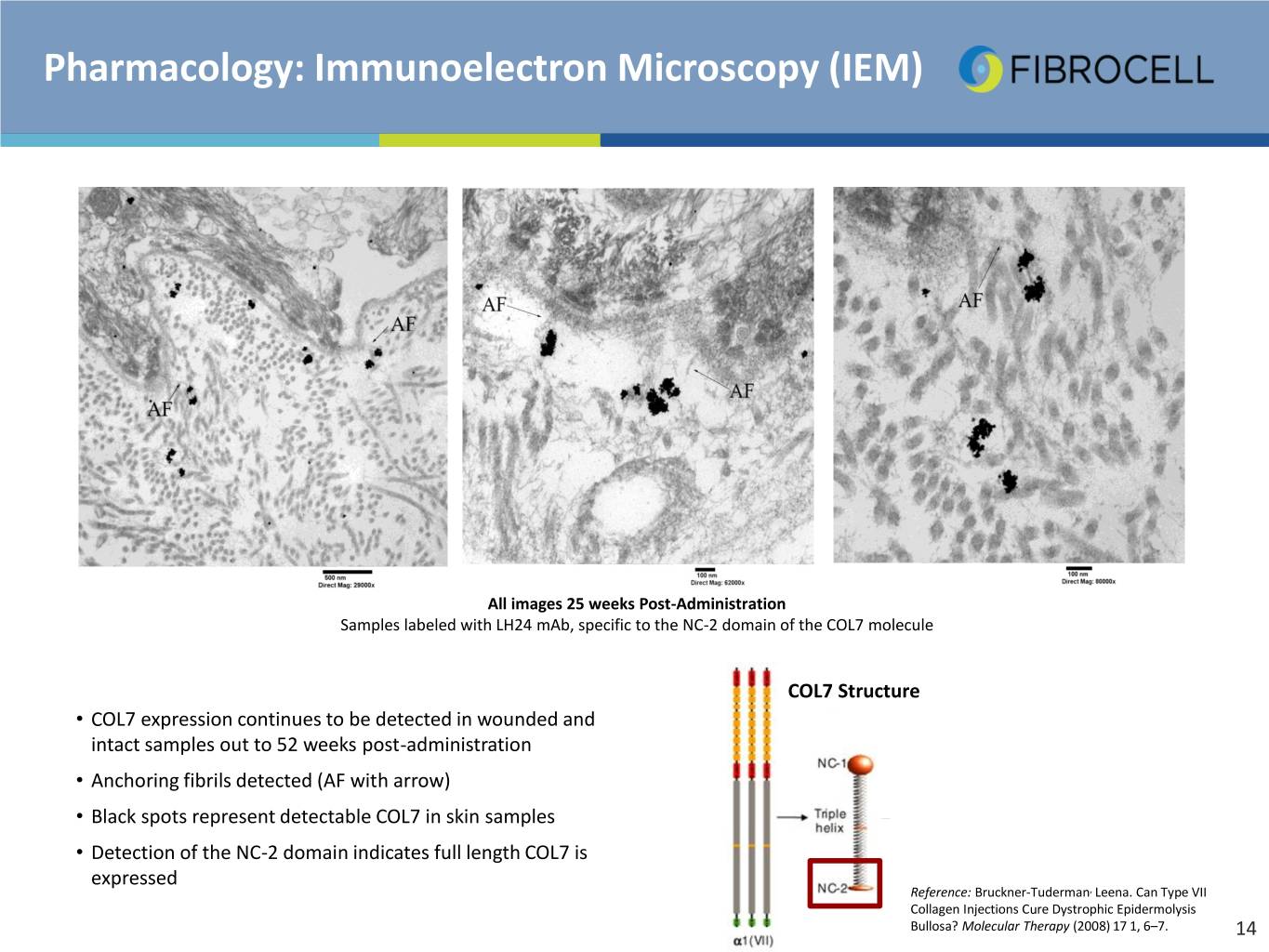
Pharmacology: Immunoelectron Microscopy (IEM) All images 25 weeks Post-Administration Samples labeled with LH24 mAb, specific to the NC-2 domain of the COL7 molecule COL7 Structure • COL7 expression continues to be detected in wounded and intact samples out to 52 weeks post-administration • Anchoring fibrils detected (AF with arrow) • Black spots represent detectable COL7 in skin samples • Detection of the NC-2 domain indicates full length COL7 is expressed Reference: Bruckner-Tuderman, Leena. Can Type VII Collagen Injections Cure Dystrophic Epidermolysis Bullosa? Molecular Therapy (2008) 17 1, 6–7. 14
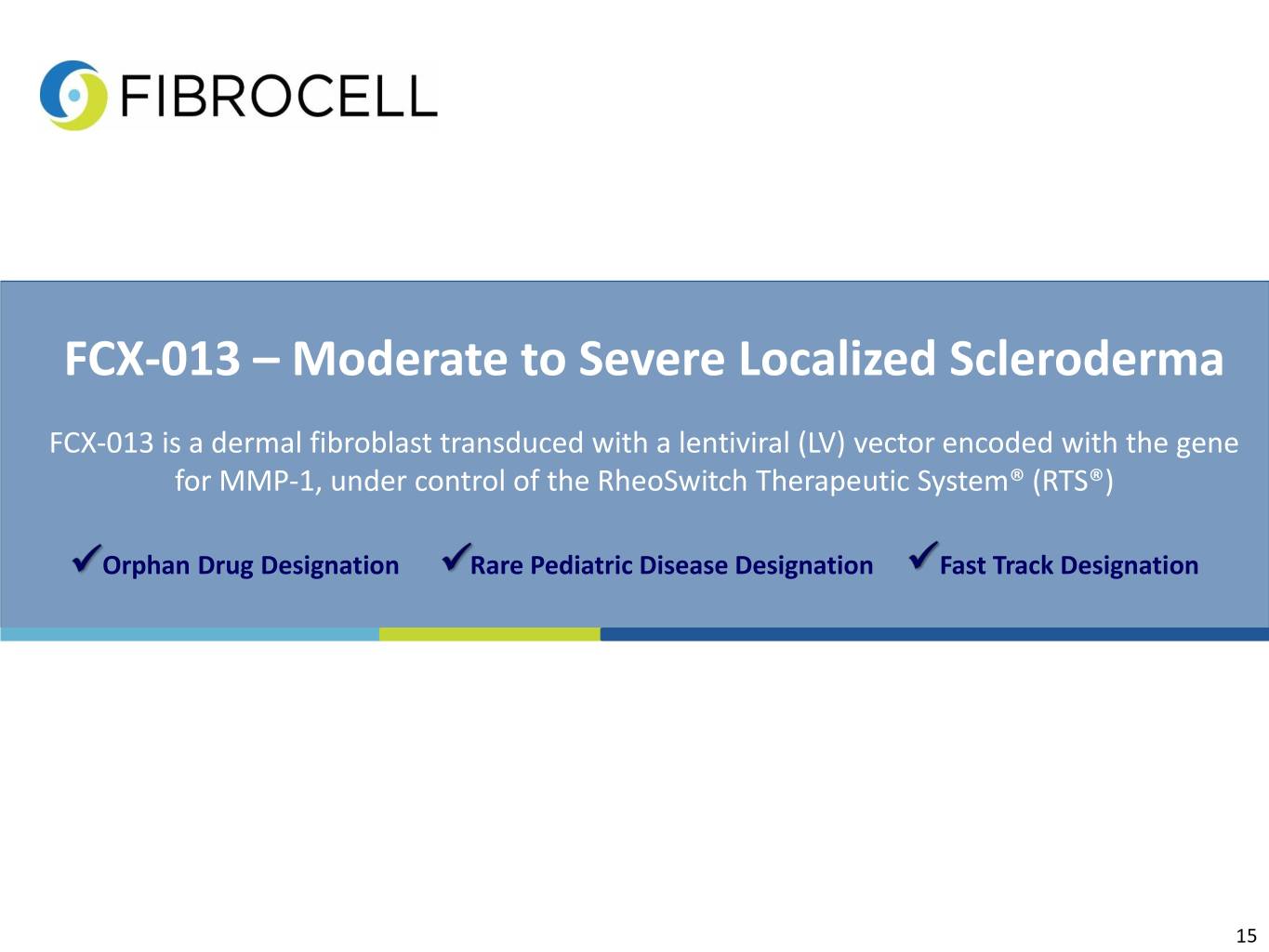
FCX-013 – Moderate to Severe Localized Scleroderma FCX-013 is a dermal fibroblast transduced with a lentiviral (LV) vector encoded with the gene for MMP-1, under control of the RheoSwitch Therapeutic System® (RTS®) Orphan Drug Designation Rare Pediatric Disease Designation Fast Track Designation 15
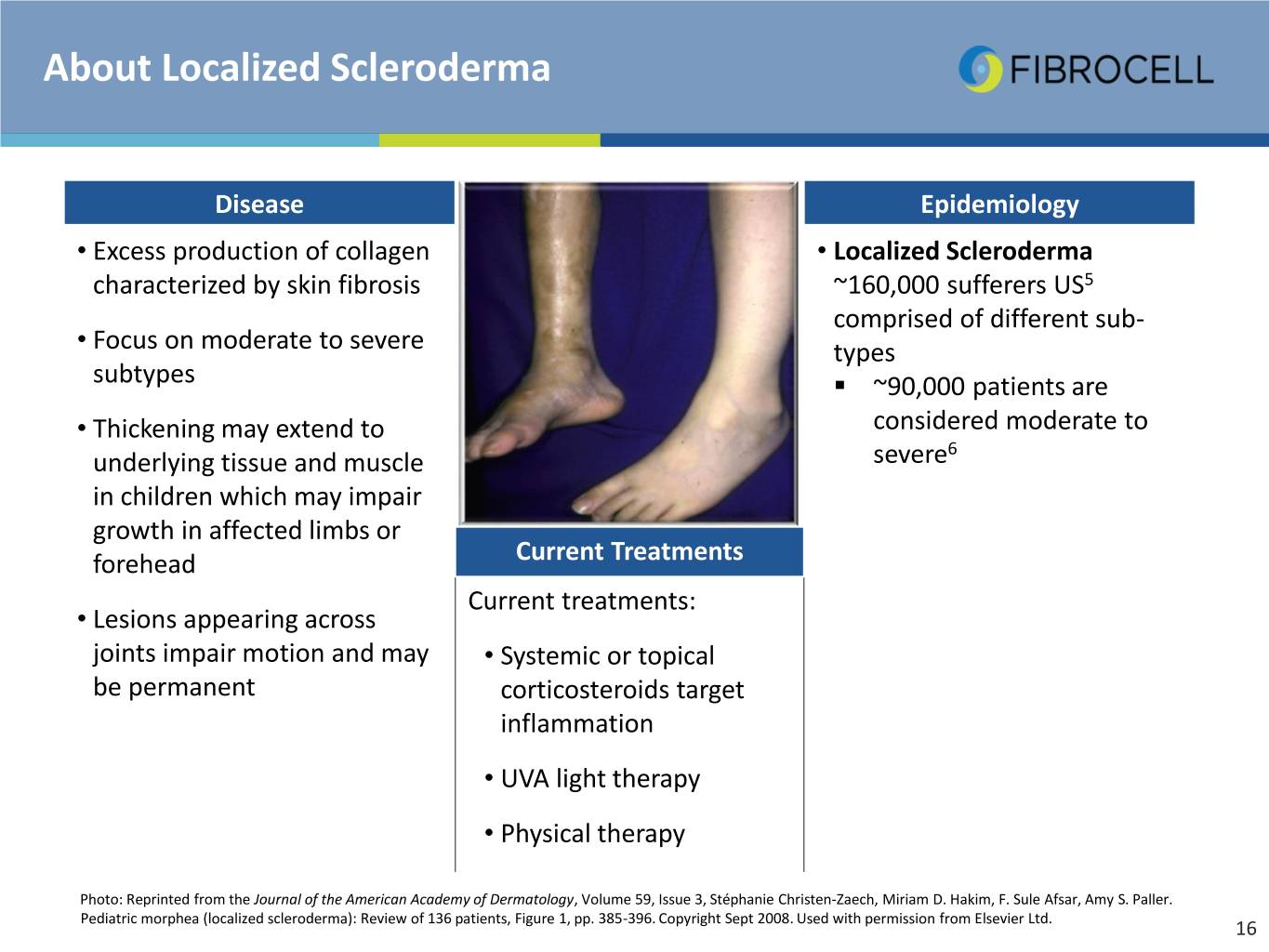
About Localized Scleroderma Disease Epidemiology • Excess production of collagen • Localized Scleroderma characterized by skin fibrosis ~160,000 sufferers US5 comprised of different sub- • Focus on moderate to severe types subtypes . ~90,000 patients are • Thickening may extend to considered moderate to 6 underlying tissue and muscle severe in children which may impair growth in affected limbs or forehead Current Treatments Current treatments: • Lesions appearing across joints impair motion and may • Systemic or topical be permanent corticosteroids target inflammation • UVA light therapy • Physical therapy Photo: Reprinted from the Journal of the American Academy of Dermatology, Volume 59, Issue 3, Stéphanie Christen-Zaech, Miriam D. Hakim, F. Sule Afsar, Amy S. Paller. Pediatric morphea (localized scleroderma): Review of 136 patients, Figure 1, pp. 385-396. Copyright Sept 2008. Used with permission from Elsevier Ltd. 16
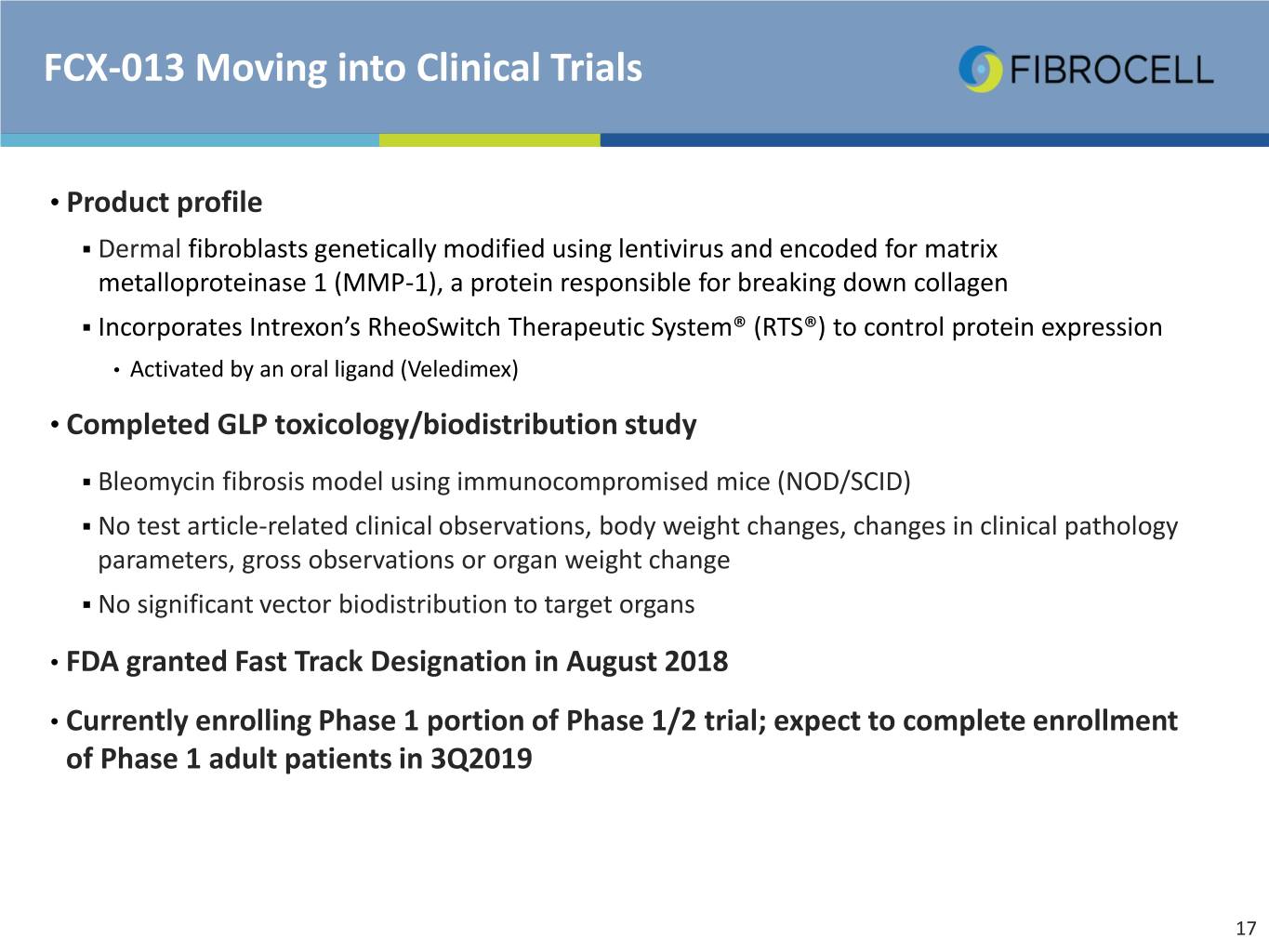
FCX-013 Moving into Clinical Trials • Product profile . Dermal fibroblasts genetically modified using lentivirus and encoded for matrix metalloproteinase 1 (MMP-1), a protein responsible for breaking down collagen . Incorporates Intrexon’s RheoSwitch Therapeutic System® (RTS®) to control protein expression • Activated by an oral ligand (Veledimex) • Completed GLP toxicology/biodistribution study . Bleomycin fibrosis model using immunocompromised mice (NOD/SCID) . No test article-related clinical observations, body weight changes, changes in clinical pathology parameters, gross observations or organ weight change . No significant vector biodistribution to target organs • FDA granted Fast Track Designation in August 2018 • Currently enrolling Phase 1 portion of Phase 1/2 trial; expect to complete enrollment of Phase 1 adult patients in 3Q2019 17
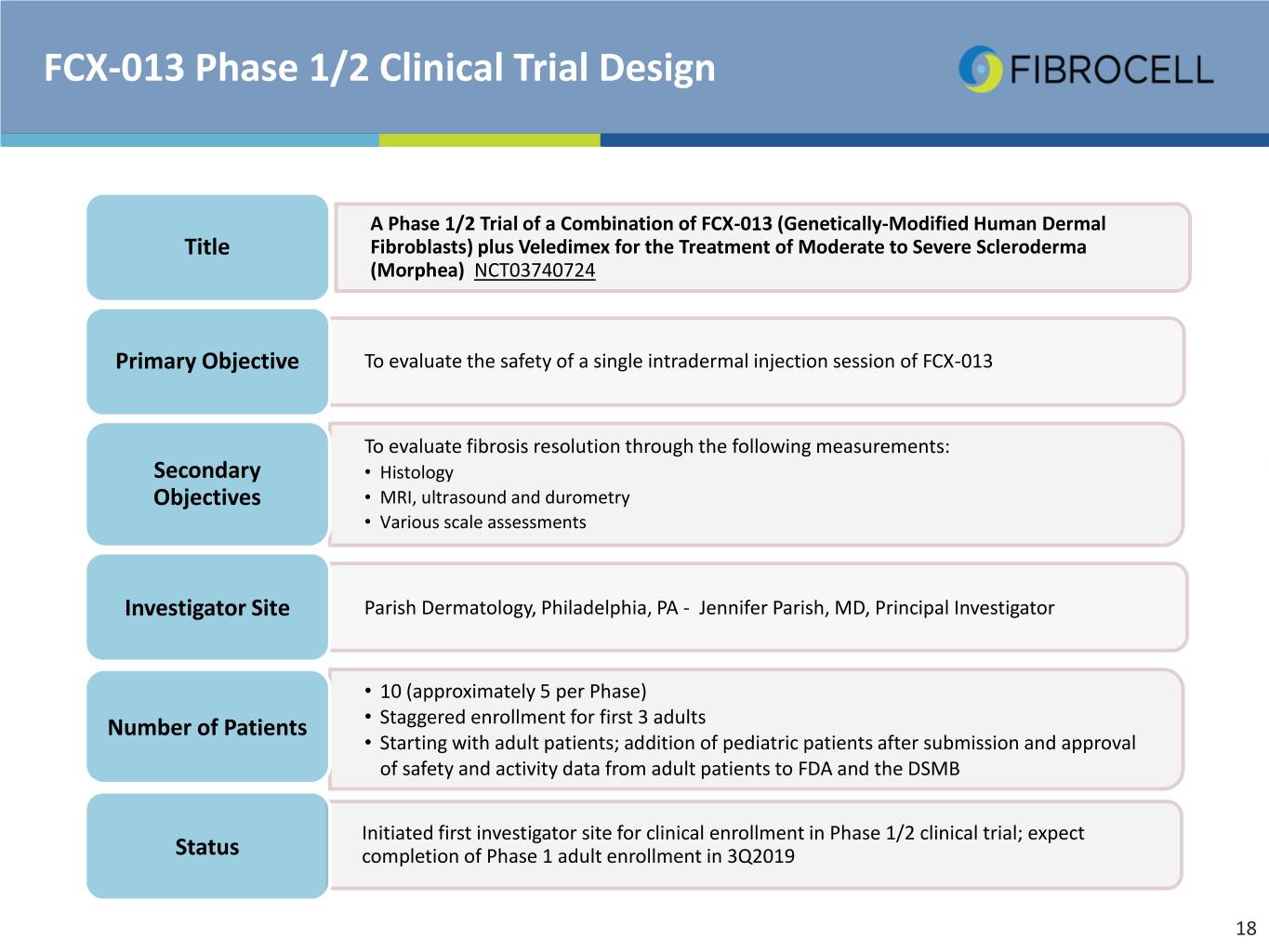
FCX-013 Phase 1/2 Clinical Trial Design A Phase 1/2 Trial of a Combination of FCX-013 (Genetically-Modified Human Dermal Title Fibroblasts) plus Veledimex for the Treatment of Moderate to Severe Scleroderma (Morphea) NCT03740724 Primary Objective To evaluate the safety of a single intradermal injection session of FCX-013 To evaluate fibrosis resolution through the following measurements: Secondary • Histology Objectives • MRI, ultrasound and durometry • Various scale assessments Investigator Site Parish Dermatology, Philadelphia, PA - Jennifer Parish, MD, Principal Investigator • 10 (approximately 5 per Phase) Number of Patients • Staggered enrollment for first 3 adults • Starting with adult patients; addition of pediatric patients after submission and approval of safety and activity data from adult patients to FDA and the DSMB Initiated first investigator site for clinical enrollment in Phase 1/2 clinical trial; expect Status completion of Phase 1 adult enrollment in 3Q2019 18
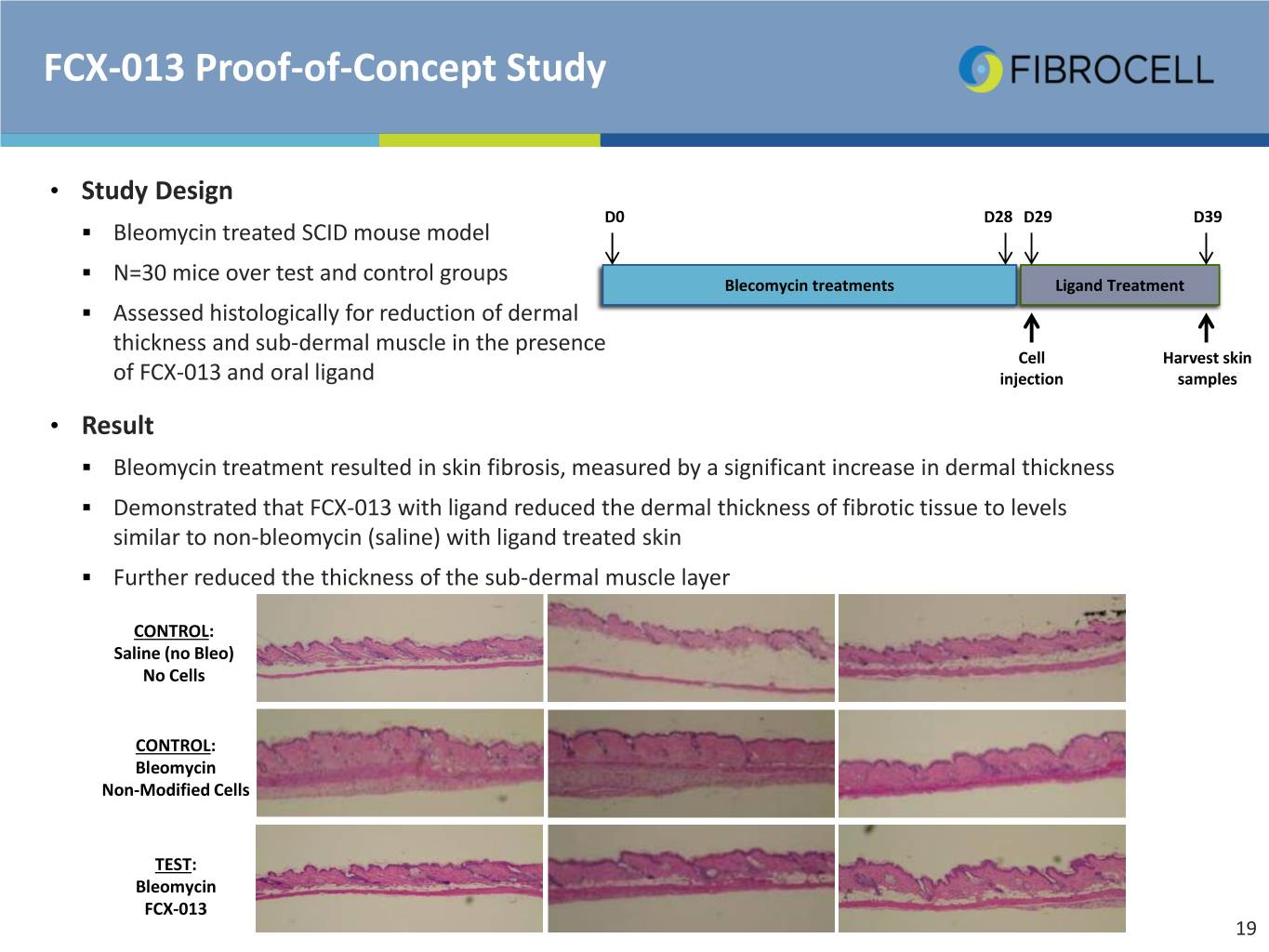
FCX-013 Proof-of-Concept Study • Study Design D0 D28 D29 D39 . Bleomycin treated SCID mouse model . N=30 mice over test and control groups Blecomycin treatments Ligand Treatment . Assessed histologically for reduction of dermal thickness and sub-dermal muscle in the presence Cell Harvest skin of FCX-013 and oral ligand injection samples • Result . Bleomycin treatment resulted in skin fibrosis, measured by a significant increase in dermal thickness . Demonstrated that FCX-013 with ligand reduced the dermal thickness of fibrotic tissue to levels similar to non-bleomycin (saline) with ligand treated skin . Further reduced the thickness of the sub-dermal muscle layer CONTROL: Saline (no Bleo) No Cells CONTROL: Bleomycin Non-Modified Cells TEST: Bleomycin FCX-013 19
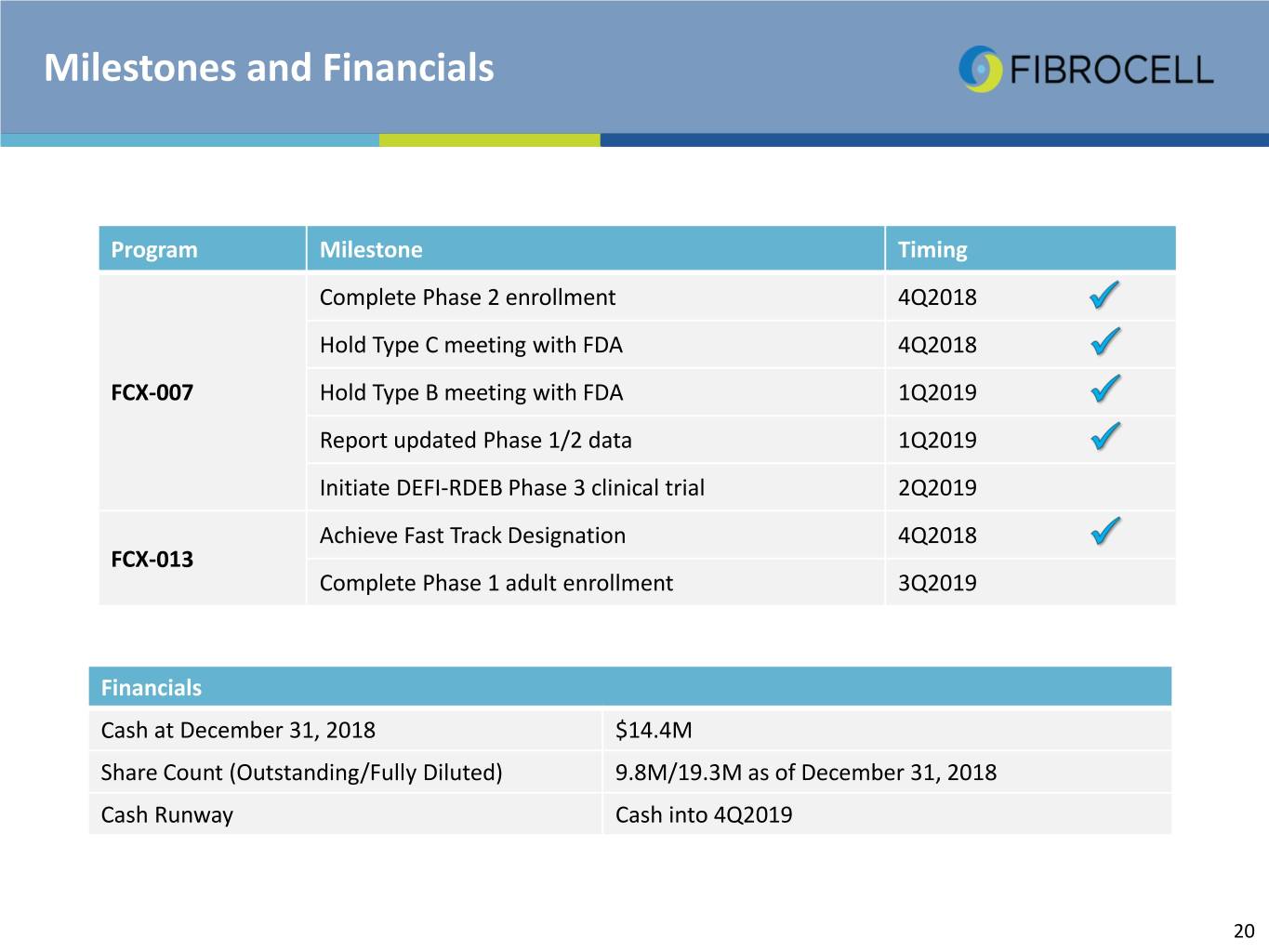
Milestones and Financials Program Milestone Timing Complete Phase 2 enrollment 4Q2018 Hold Type C meeting with FDA 4Q2018 FCX-007 Hold Type B meeting with FDA 1Q2019 Report updated Phase 1/2 data 1Q2019 Initiate DEFI-RDEB Phase 3 clinical trial 2Q2019 Achieve Fast Track Designation 4Q2018 FCX-013 Complete Phase 1 adult enrollment 3Q2019 Financials Cash at December 31, 2018 $14.4M Share Count (Outstanding/Fully Diluted) 9.8M/19.3M as of December 31, 2018 Cash Runway Cash into 4Q2019 20
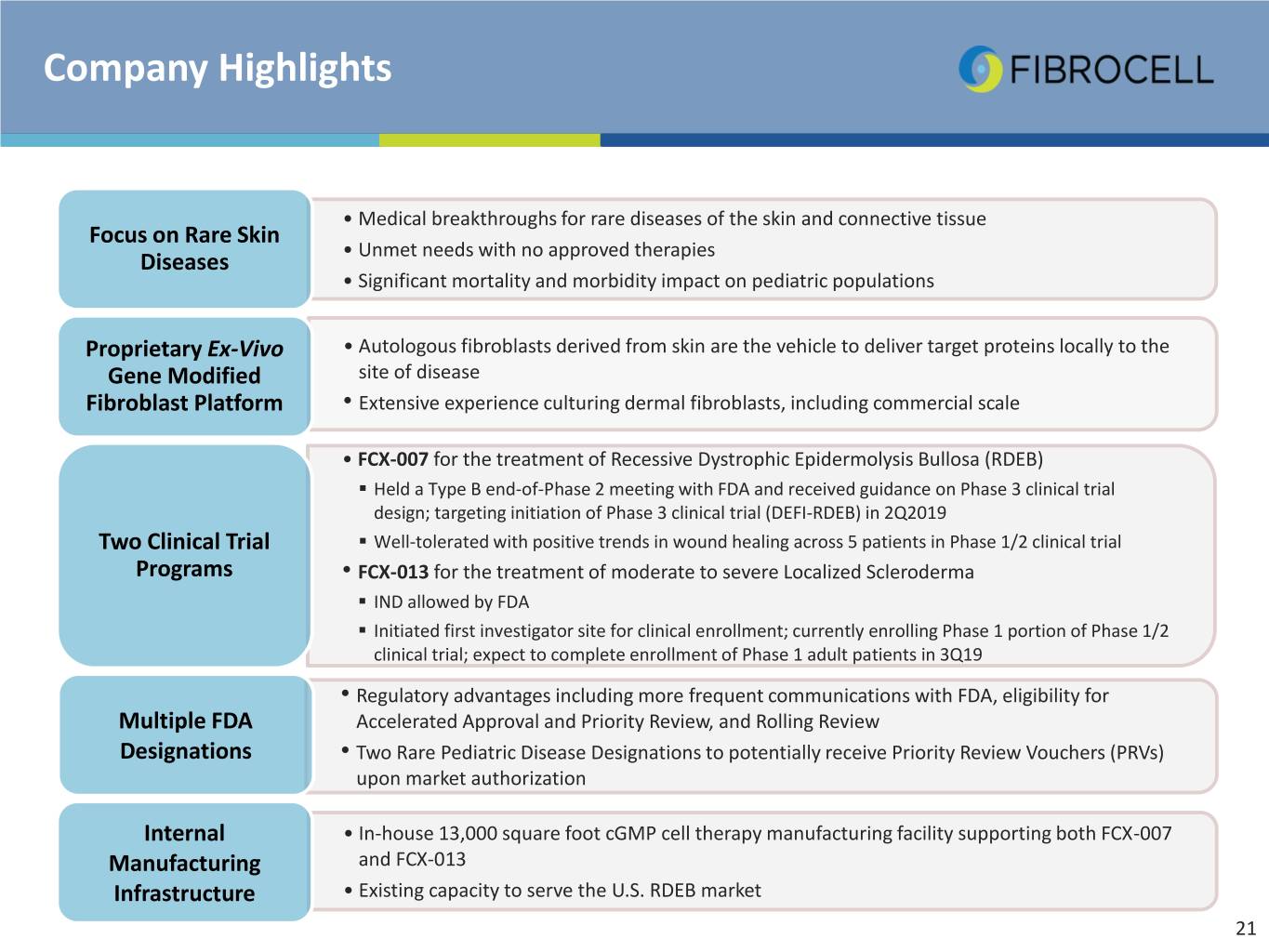
Company Highlights • Medical breakthroughs for rare diseases of the skin and connective tissue Focus on Rare Skin • Unmet needs with no approved therapies Diseases • Significant mortality and morbidity impact on pediatric populations Proprietary Ex-Vivo • Autologous fibroblasts derived from skin are the vehicle to deliver target proteins locally to the Gene Modified site of disease Fibroblast Platform • Extensive experience culturing dermal fibroblasts, including commercial scale • FCX-007 for the treatment of Recessive Dystrophic Epidermolysis Bullosa (RDEB) . Held a Type B end-of-Phase 2 meeting with FDA and received guidance on Phase 3 clinical trial design; targeting initiation of Phase 3 clinical trial (DEFI-RDEB) in 2Q2019 Two Clinical Trial . Well-tolerated with positive trends in wound healing across 5 patients in Phase 1/2 clinical trial Programs • FCX-013 for the treatment of moderate to severe Localized Scleroderma . IND allowed by FDA . Initiated first investigator site for clinical enrollment; currently enrolling Phase 1 portion of Phase 1/2 clinical trial; expect to complete enrollment of Phase 1 adult patients in 3Q19 • Regulatory advantages including more frequent communications with FDA, eligibility for Multiple FDA Accelerated Approval and Priority Review, and Rolling Review Designations • Two Rare Pediatric Disease Designations to potentially receive Priority Review Vouchers (PRVs) upon market authorization Internal • In-house 13,000 square foot cGMP cell therapy manufacturing facility supporting both FCX-007 Manufacturing and FCX-013 Infrastructure • Existing capacity to serve the U.S. RDEB market 21
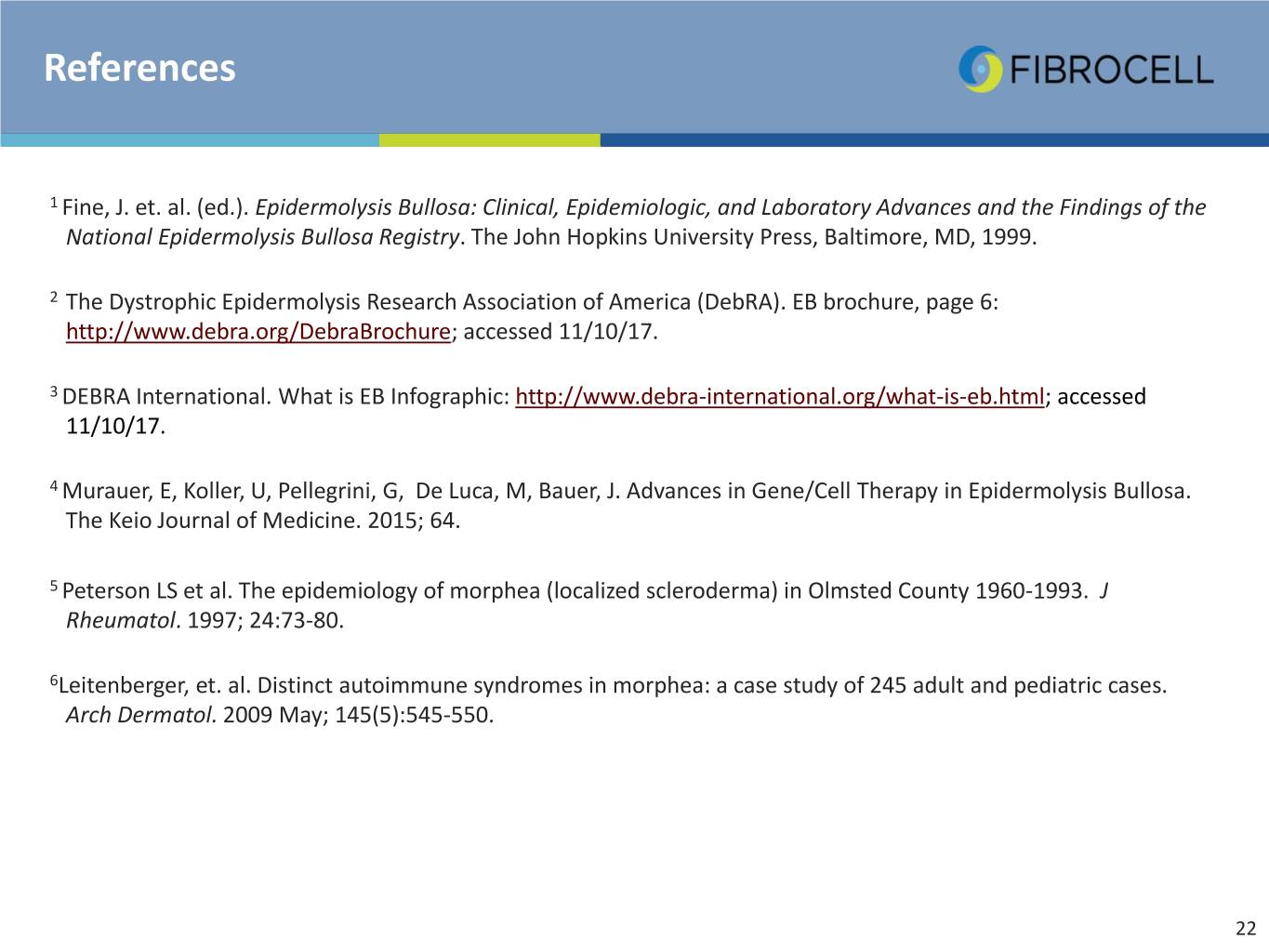
References 1 Fine, J. et. al. (ed.). Epidermolysis Bullosa: Clinical, Epidemiologic, and Laboratory Advances and the Findings of the National Epidermolysis Bullosa Registry. The John Hopkins University Press, Baltimore, MD, 1999. 2 The Dystrophic Epidermolysis Research Association of America (DebRA). EB brochure, page 6: http://www.debra.org/DebraBrochure; accessed 11/10/17. 3 DEBRA International. What is EB Infographic: http://www.debra-international.org/what-is-eb.html; accessed 11/10/17. 4 Murauer, E, Koller, U, Pellegrini, G, De Luca, M, Bauer, J. Advances in Gene/Cell Therapy in Epidermolysis Bullosa. The Keio Journal of Medicine. 2015; 64. 5 Peterson LS et al. The epidemiology of morphea (localized scleroderma) in Olmsted County 1960-1993. J Rheumatol. 1997; 24:73-80. 6Leitenberger, et. al. Distinct autoimmune syndromes in morphea: a case study of 245 adult and pediatric cases. Arch Dermatol. 2009 May; 145(5):545-550. 22





















